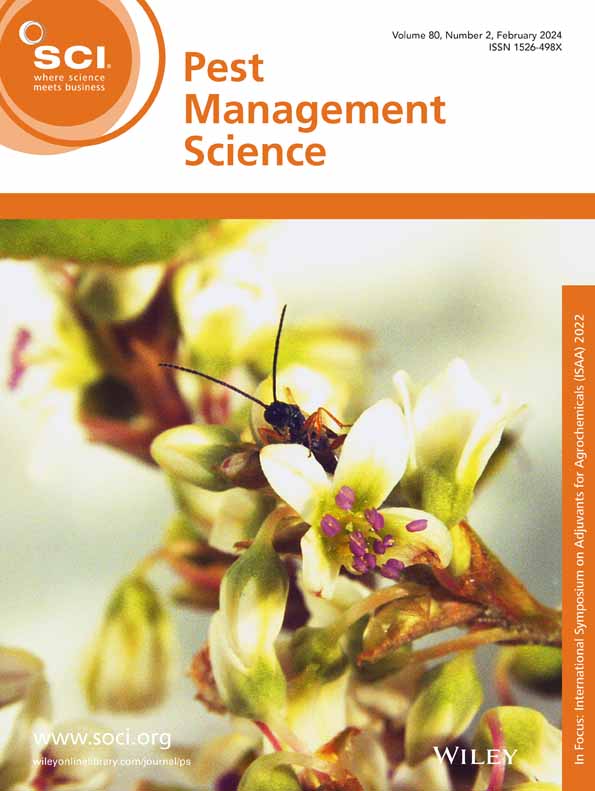求助PDF
{"title":"Discovering the antibacterial activity of tryptanthrin derivatives for controlling kiwifruit canker and tobacco wilt disease","authors":"Mei Zhu, Jiawang Yan, Xuesha Long, Guiping Ouyang","doi":"10.1002/ps.8757","DOIUrl":null,"url":null,"abstract":"BACKGROUNDPlant bacterial diseases have severely affected the yield and quality of agricultural products, among which kiwifruit canker and bacterial wilt disease, caused by <jats:italic>Pseudomonas syringae</jats:italic> pv. <jats:italic>actinidiae</jats:italic> (<jats:italic>Psa</jats:italic>) and <jats:italic>Ralstonia solanacearum</jats:italic> (<jats:italic>Rs</jats:italic>), respectively, seriously restrict the development of the related industry. However, there are few effective green agents available to target these diseases.RESULTSHerein, we synthesized 41 novel derivatives of the natural product tryptanthrin, among which partial compounds showed noticeable antibacterial activity against <jats:italic>Psa</jats:italic> and <jats:italic>Rs</jats:italic>. Compounds T7NO‐4 and T7NH‐2 can affect bacterial biofilm formation, change the membrane permeability, and cause bacterial necrosis. Compound T7NO‐4 exhibits effective control activity against kiwifruit canker disease, with protective and curative efficiency of 75.61% and 66.84%, respectively. Compound T7NH‐2 exhibits good protective activity against tobacco wilt disease but poor curative activity. To improve its curative activity, considering the characteristic that bacterial wilt disease is more prone to outbreak under weakly acidic soil conditions, introducing a ZIF‐8 framework to make T7NH‐2@ZIF‐8 nanoparticles that exhibit pH‐responsive release, then making T7NH‐2@ZIF‐8@TA through modifying with tannic acid (TA). T7NH‐2@ZIF‐8@TA nanoparticles exhibit superior efficacy against tobacco wilt disease.CONCLUSIONThis study demonstrates that 7‐piperazine tryptanthrin derivatives exhibit good inhibitory activity against <jats:italic>Psa</jats:italic> and <jats:italic>Rs</jats:italic> and may be promising lead agents against plant bacterial diseases, with improved biological activity through being loaded into nanocarriers. © 2025 Society of Chemical Industry.","PeriodicalId":218,"journal":{"name":"Pest Management Science","volume":"16 1","pages":""},"PeriodicalIF":3.8000,"publicationDate":"2025-03-11","publicationTypes":"Journal Article","fieldsOfStudy":null,"isOpenAccess":false,"openAccessPdf":"","citationCount":"0","resultStr":null,"platform":"Semanticscholar","paperid":null,"PeriodicalName":"Pest Management Science","FirstCategoryId":"97","ListUrlMain":"https://doi.org/10.1002/ps.8757","RegionNum":1,"RegionCategory":"农林科学","ArticlePicture":[],"TitleCN":null,"AbstractTextCN":null,"PMCID":null,"EPubDate":"","PubModel":"","JCR":"Q1","JCRName":"AGRONOMY","Score":null,"Total":0}
引用次数: 0
引用
批量引用
Abstract
BACKGROUNDPlant bacterial diseases have severely affected the yield and quality of agricultural products, among which kiwifruit canker and bacterial wilt disease, caused by
Pseudomonas syringae pv.
actinidiae (
Psa ) and
Ralstonia solanacearum (
Rs ), respectively, seriously restrict the development of the related industry. However, there are few effective green agents available to target these diseases.RESULTSHerein, we synthesized 41 novel derivatives of the natural product tryptanthrin, among which partial compounds showed noticeable antibacterial activity against
Psa and
Rs . Compounds T7NO‐4 and T7NH‐2 can affect bacterial biofilm formation, change the membrane permeability, and cause bacterial necrosis. Compound T7NO‐4 exhibits effective control activity against kiwifruit canker disease, with protective and curative efficiency of 75.61% and 66.84%, respectively. Compound T7NH‐2 exhibits good protective activity against tobacco wilt disease but poor curative activity. To improve its curative activity, considering the characteristic that bacterial wilt disease is more prone to outbreak under weakly acidic soil conditions, introducing a ZIF‐8 framework to make T7NH‐2@ZIF‐8 nanoparticles that exhibit pH‐responsive release, then making T7NH‐2@ZIF‐8@TA through modifying with tannic acid (TA). T7NH‐2@ZIF‐8@TA nanoparticles exhibit superior efficacy against tobacco wilt disease.CONCLUSIONThis study demonstrates that 7‐piperazine tryptanthrin derivatives exhibit good inhibitory activity against
Psa and
Rs and may be promising lead agents against plant bacterial diseases, with improved biological activity through being loaded into nanocarriers. © 2025 Society of Chemical Industry.
色氨酸衍生物对猕猴桃溃疡病和烟草枯萎病的抑菌活性研究
植物细菌性病害严重影响农产品的产量和品质,其中由丁香假单胞菌引起的猕猴桃溃疡病和细菌性枯萎病。actinidiae (Psa)和Ralstonia solanacearum (Rs)分别严重制约了相关产业的发展。然而,很少有有效的绿色药剂可用于这些疾病。结果合成了天然产物色氨酸的41个新衍生物,其中部分化合物对Psa和Rs具有明显的抑菌活性。化合物T7NO‐4和T7NH‐2可以影响细菌生物膜的形成,改变膜的通透性,导致细菌坏死。化合物T7NO‐4对猕猴桃溃疡病有较好的防治作用,保护率为75.61%,治疗率为66.84%。化合物T7NH‐2对烟草枯萎病具有良好的保护作用,但治疗作用较差。为了提高其治疗活性,考虑到青枯病在弱酸性土壤条件下更容易爆发的特点,引入ZIF‐8框架制备具有pH响应释放的T7NH‐2@ZIF‐8纳米颗粒,然后通过单宁酸(TA)修饰制备T7NH‐2@ZIF‐8@TA纳米颗粒。T7NH‐2@ZIF‐8@TA纳米颗粒对烟草枯萎病具有优异的防治效果。结论7‐哌嗪类色胺菊酯衍生物对Psa和Rs具有良好的抑制活性,可作为防治植物细菌性病害的先导剂,通过载于纳米载体中提高生物活性。©2025化学工业协会。
本文章由计算机程序翻译,如有差异,请以英文原文为准。


 求助内容:
求助内容: 应助结果提醒方式:
应助结果提醒方式:


